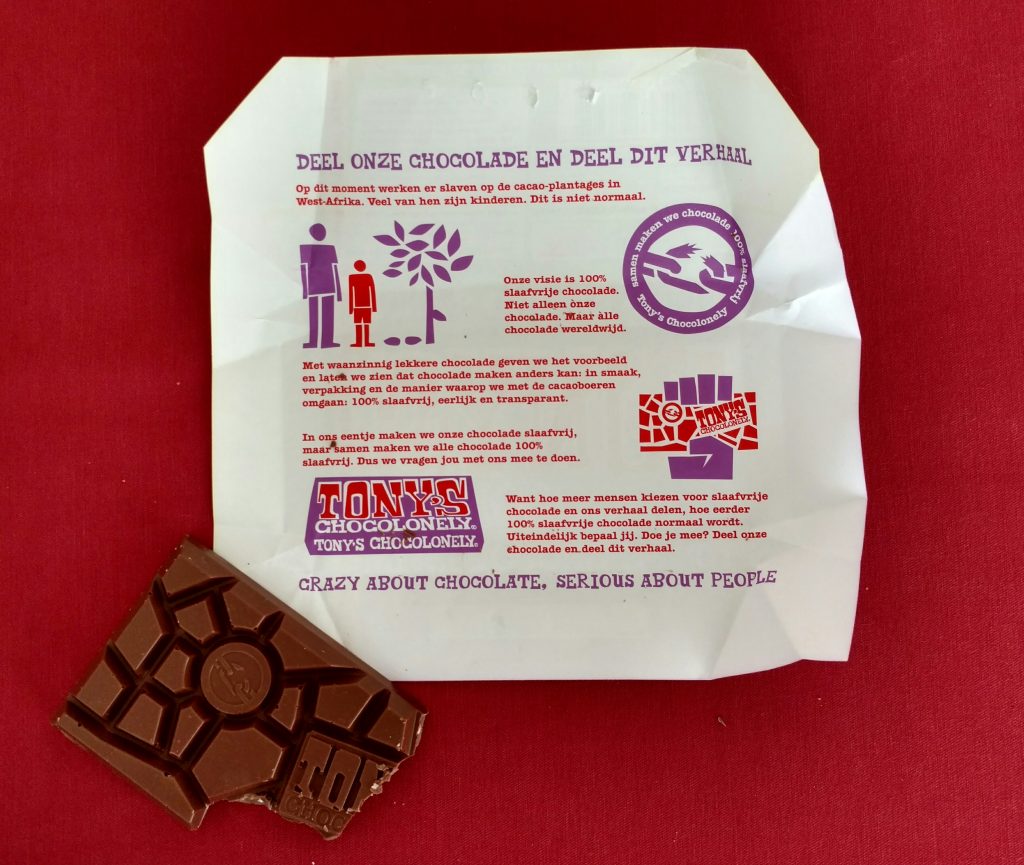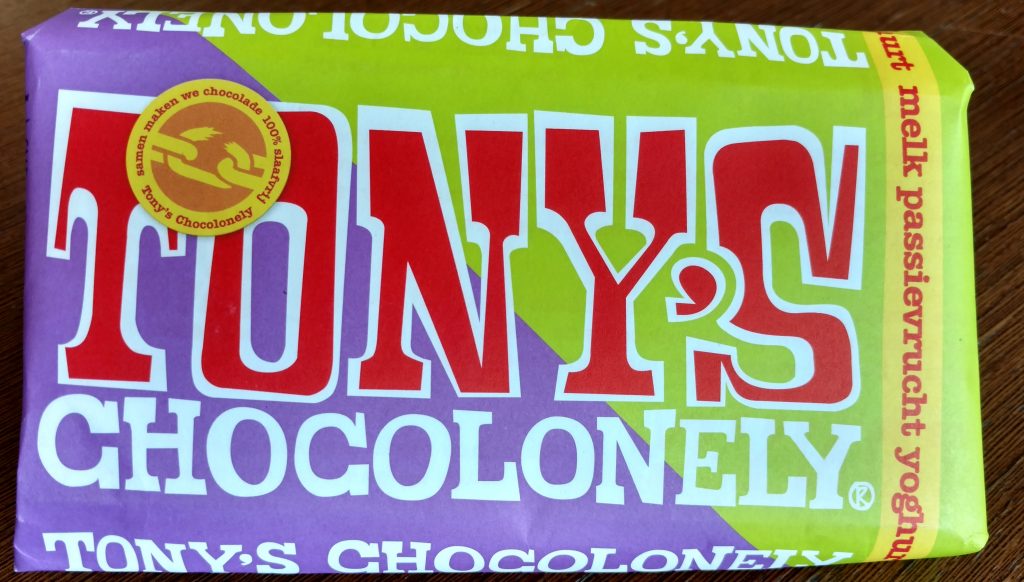Can You Say This Correctly? – 3: Tony’s Chocolonely Melk Passievrucht Yoghurt – C: [s] or [k]? Posted by Sten on May 20, 2016 in Culture, Dutch Grammar, Dutch Language, Dutch Vocabulary
One of the hardest things about learning Dutch is pronunciation. Whether it is about the ui-klank (the “ui” sound), the G-klank (the “G” sound) or other sounds you might have a hard time with. This series, called “Can You Say This Correctly?”, is about providing a speech example that I recorded. I will give the Dutch text, a translation, and I will add one comment or more for parts that you have to heed for pronunciation. If there are any sounds that you would like to see a post about, let me know in the comments!
OTHER PARTS OF THE SERIES
Part 1: Arla Biologische Volle Melk – how to pronounce long and short vowels
Part 2: Innocent Goedgemutste Smoothie – how to pronounce ei, ij, ie, -je, -pje, -tje
Part 4: Tony’s Chocolonely Puur – how to pronounce samenstellingen
Part 5: Can You Say This Correctly? – 5: Fair Trade Basmatirijst – How to pronounce ij

The inside of the wikkel (wrapper), with the special shape of the chocolate. This is the text you read below!

The package of Tony’s Chocolonely Chocolate in the flavor melk, passievrucht, yoghurt (milk, passion fruit, yogurt)
THE RECORDING
The recording of the Dutch text:
THE TEXT
Deel onze chocolade en deel dit verhaal.
Op dit moment werken er slaven op de cacao-plantages in West-Afrika. Veel van hen zijn kinderen. Dit is niet normaal.
Onze visie is 100 procent (%) slaafvrije chocolade. Niet alleen ònze chocolade. Maar àlle chocolade wereldwijd.
Met waanzinnig lekkere chocolade geven we het voorbeeld en laten we zien dat chocolade maken anders kan: in smaak, verpakking en de manier waarop we met de cacaoboeren omgaan: 100% slaafvrij, eerlijk en transparant.
In ons eentje maken we onze chocolade slaafvrij, maar samen maken we alle chocolade 100% slaafvrij. Dus we vragen jou met ons mee te doen.
Want hoe meer mensen kiezen voor slaafvrije chocolade en ons verhaal delen, hoe eerder 100% slaafvrije chocolade normaal wordt. Uiteindelijk bepaal jij. Doe je mee? Deel onze chocolade en deel dit verhaal.
Crazy about chocolate, serious about people.
THE TRANSLATION
Share our chocolate and share this story.
At the moment, slaves are working on cocoa plantations in West Africa. Many of them are children. This is not normal.
With insanely delicious chocolate we give the example and show that making chocolate can be done differently: in taste, packaging, and the way in which we treat cocoa farmers: 100% slave-free, fair and transparent.
On our own, we make our chocolate slave-free, but together we make our chocolate 100% slave-free. So we ask you to join in with us.
Because the more people choose slave-free chocolate and share our story, the sooner 100% slave-free chocolate becomes normal. In the end, you decide. Do you join us? Share our chocolate and share this story.
Crazy about chocolate, serious about people.
TONY’S CHOCOLONELY – THE STORY
Before we get into the grammatical part of this post, I will explain a little about Tony’s Chocolonely. As you might have guessed from the text above, they are not your usual chocolate manufacturer. They release different flavors every so often, and have very crazy, but awesome flavors, such as the one of this post: melk, passievrucht, yoghurt (milk, passion fruit, yogurt). And I think it tastes awesome. The shape of their bars is different, too. They found it weird that a chocolate bar is divided in equal squares, even though chocolate production is not fair at all.
If that wasn’t already enough, the chocolate manufacturer started 10 years ago with the goal of 100% slaafvrije chocolade. However, the amount of (child) slavery has actually increased since then, and the impact of Tony’s is, according to themselves, een druppel op een hete plaat (a drop on a hot plate).
How did they get to this weird name? Tony is the anglicization of Teun, the name of the founder of the brand, who even wanted to get himself sued once for eating chocolate produced with slavery, calling himself a chocoladecrimineel (chocolate criminal). The “Chocolonely” is a samentrekking (contraction) of “chocolate” and “lonely”, and was chosen because Teun felt like he was the only one in the chocolate industry that is fighting for 100% slave-free chocolate.
If you want to know more about what the company does, check out their website, or check out the documentary they made about their cause! Here is a trailer:
Anyway, on to the comments!
COMMENTS
chocolade; cacao
The main thing I want to focus on here is the pronunciation of the c in the words chocolade and cacao. As in English, the c is pronounced as a [k]. Why?
The letter “c” is always pronounced as a [k] if it comes before an a, o or u.
De letter c spreken we voor een i of een e altijd uit als een [s], voor een a, een o of een u als een [k] (uitzonderingen zijn scepter en sceptisch).
procent
In the case of the word procent, it is the other way around. You can see why: there is an e after the c in procent! The rule here is:
The letter c is always pronounced as a [c] if it comes before an i or an e.
Exceptions to this are scepter (sceptre) and sceptisch (skeptical) (c pronounced as [k] here!). But “skeptical” also has a weird spelling in English…
MISTAKES
ònze, àlle
One mistake I have found in their text is in how the so-called klemtoonteken (stress mark) or nadrukteken (emphasis mark) is used. In Dutch, this is supposed to always be an accent aigu (´), e.g. er zijn nóg meer dingen te beleven! (There are even more things to experience!). I have also found this mistake on their website.
What the company has done here is use the accent grave (`) as a klemtoonteken. And that is incorrect. It is used in Dutch sometimes to clarify how to pronounce a word, for example appèl (appeal, call), compared to appel (apple). Listen here for the difference:
Another small mistake, which is more a stylistic choice, but purely technically incorrect, is their sentence structure. For example, a sentence that starts with maar (but), is incorrect in the Netherlands, as it should follow right after a comma to introduce a contradiction to the previous. But that is not a big deal! (Here you go! 😉 )
FINAL NOTES
slaafvrij
Slaafvrije is not an actual Dutch word, but was created by Tony’s crew back in the days. It is a samenstelling (compound) of the words slaaf (slave) and vrij (free). Slaafvrij is easier to work with than zonder slavernij geproduceerd (produced without slavery).
Such a new word is called a neologisme (neologism).
On a final note, just before I go, I have a little extra for you: can you translate their slogan Crazy about chocolate, serious about people to Dutch? Give your translation below in the comments, or let us know in a Facebook message!
Of course, you can also reach us for any other question, comment or remark you might have.

Build vocabulary, practice pronunciation, and more with Transparent Language Online. Available anytime, anywhere, on any device.
About the Author: Sten
Hi! I am Sten, both Dutch and German. For many years, I've written for the German and the Dutch blogs with a passion for everything related to language and culture. It's fascinating to reflect on my own culture, and in the process allow our readers to learn more about it! Besides blogging, I am a German-Dutch-English translator, animator and filmmaker.





Comments:
Ann McCloskey:
Gek over chocolade, seriuse over mensen.
vivianne:
Dol op chocolade, serieus over mensen